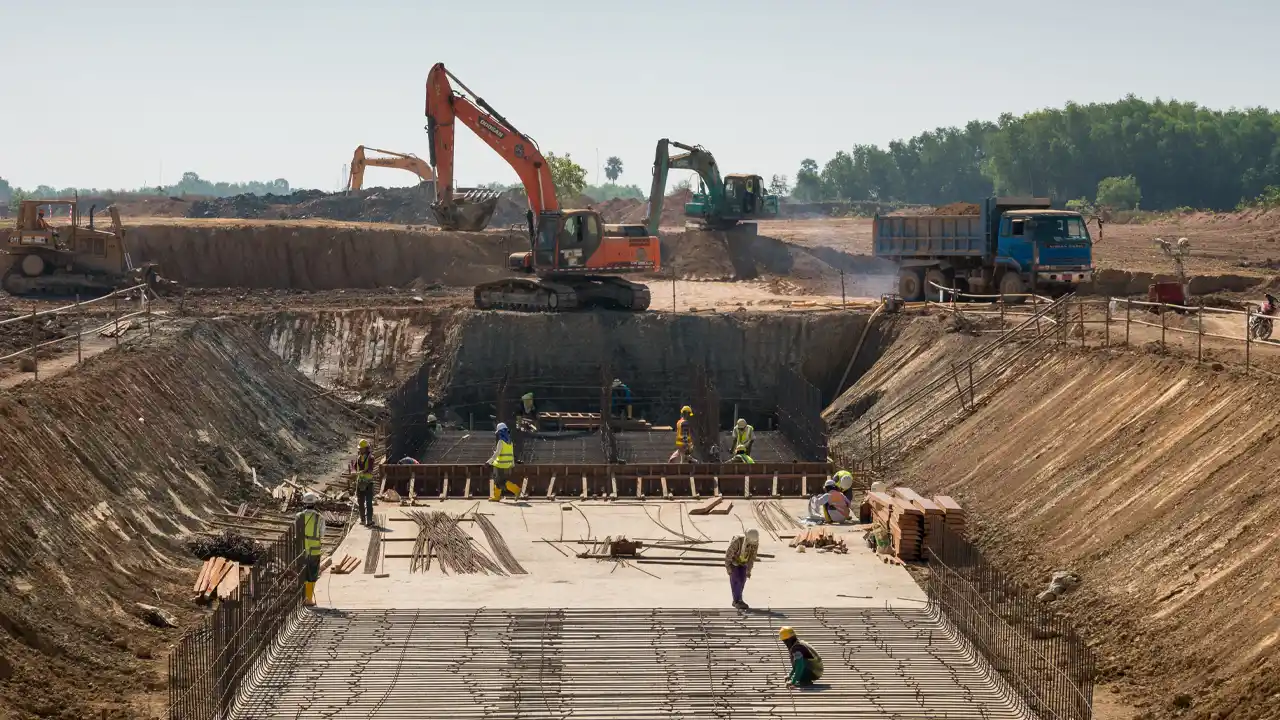Earthwork Construction activities are executed with loose soil. The digging and filling of the earth. Earthworks are really important in civil engineering. They are the foundation for other types of construction. In simple words, besides building stuff, this also involves figuring out how to do it and doing some maths based on the properties of the ground.
Earthworks are very important for building roads, railways, water projects, landfills, and tunnels. Professional earthworks need to have a well-planned construction design, an examination of the soil, and possibly a study of its stability, depending on how complicated the project is. Common earthworks involve building up or digging down the land, creating barriers, trenches, or holes. It also includes making the soil better, by replacing or improving it using specific materials like geosynthetics. Many different types of materials, such as non-wovens, geogrids, woven fabrics, sealing membranes, drainage membranes, and erosion control mats, are commonly utilized for separating and filtering purposes.
Discover How the Crucial Earthwork Construction Process Shapes the Foundation of Our Infrastructure. Read the Full Article Now!
Earthwork Projects
Earthworks are different projects that deal with digging or moving soil around. Various projects are:
Land Grading
Land grading means making the ground level for activities like adding materials or getting ready to construct something new. For example, the ground should be leveled before adding paving stones. However, leveling can also be used to solve a problem with how water flows when the ground is sloped in the wrong direction.
Digging
It is the process of excavating holes or trenches. Digging is very important when putting a pool in the ground or building an underground house structure. When engaging in Residential and Commercial mining, it is crucial to exercise great caution. One must take care to prevent damage to underground pipes, gas lines, cables, and other hydraulic, electrical, or communications equipment.
Land Clearing
It is the procedure of removing bushes, flowers, and other plants from a piece of land. Land clearing manner setting out the pinnacle layer of soil from the ground. During this stage, all tree particles like roots, branches, and leaves, in addition to topsoil, are absolutely taken away.
Backfilling
Backfilling involves the use of soil to support and reinforce a shape. The soil used for backfilling can originate from the excavation of foundations, floor-bearing slabs, or groundwork. It can also consist of newly imported soils, rocks, and stones based entirely on structural requirements.
Getting Rid of Dirt and Throwing It Away
Getting rid of soil is also included in earthworks. This is needed when a lot of dirt has been dug up and needs to be taken away from the area.
Earthworks Tools
Earthwork tools are the machinery used for construction projects involving the manipulation of the earth’s surface, such as digging, leveling, and moving soil. Depending on the type and size of the project, earthworks may need different types of machinery.
Big and powerful machines like loaders, backhoes, and graders are really helpful for doing big earthwork projects quickly and easily. However, mini-excavators and traction loaders are very flexible and can help complete residential or jobs in small spaces quickly.
Materials Used in Earthwork
Fill Materials
Workers use soil, gravel, and crushed rock as fill to construct embankments and raise ground levels. They compress these materials to establish a solid foundation for the building and to adjust elevations as needed.
Geosynthetics
The use of geosynthetic materials, such as geotextiles and geomembranes, improves soil stability, prevents erosion, enhances drainage, and regulates sediment. These materials frequently work in tandem with natural materials to give affordable solutions to diverse geotechnical problems.
Aggregates
In various earthwork procedures, workers use aggregates such as sand, gravel, and crushed stone. These materials play a crucial role in ensuring adequate compaction, providing drainage, and enhancing the overall characteristics of the soil.
Learn How Proper Earthwork Can Make or Break Your Project! Read Our Article and Build With Confidence!
Significance of Earthwork
Earthwork is the preliminary step in any creation mission and serves as the canvas upon which the whole development unfolds. It entails the excavation, grading, compaction, and backfilling of soil to establish a stable platform for structures, roads, and utilities.
Properly performed earthwork guarantees the steadiness, protection, and longevity of a creation project by means of presenting a stable basis that can endure the structural loads and environmental forces it will face through the years.
Technologies Influencing Earthwork
Three excavation technologies influencing earthwork process execution are:
3D Maps
A complete perspective of the location is provided using 3D scanners. This makes it easier to spot voids, impediments, and other problems before you even begin digging.
Modeling of Building Information
Building time is crucial for undertakings with high risks and stress. You may build out projects, envision constructions, and communicate your concept to others with the use of intelligent 3-D modeling software.
Grade Assist Automation
Your excavators could be equipped with the most recent grade assist technology depending on the kind of equipment you utilize. This entails that you may program the motions of the boom and bucket for automated, more precise cuts.
Wrapping Up
Earthwork Construction projects can progress smoothly when there is proper planning, meticulous execution, and utilization of modern technology in digging and moving dirt. As technology keeps getting better, the future of earthwork has a lot of potential for working faster, causing less damage to the environment, and achieving better construction results. By learning about the details of earthwork and using creative ideas, the construction industry can keep making a better base for future infrastructure.

